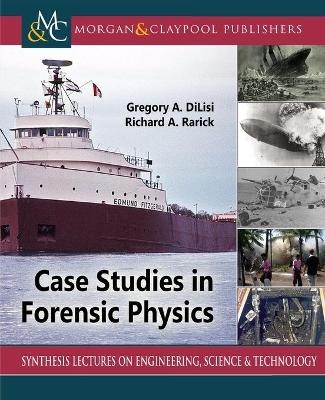
Case Studies in Forensic Physics
Morgan & Claypool Publishers (Verlag)
978-1-68173-876-5 (ISBN)
- Lieferbar
- Versandkostenfrei
- Auch auf Rechnung
- Artikel merken
This book focuses on a forensics-style re-examination of several historical events. The purpose of these studies is to afford readers the opportunity to apply basic principles of physics to unsolved mysteries and controversial events in order to settle the historical debate. We identify nine advantages of using case studies as a pedagogical approach to understanding forensic physics. Each of these nine advantages is the focus of a chapter of this book. Within each chapter, we show how a cascade of unlikely events resulted in an unpredictable catastrophe and use introductory-level physics to analyze the outcome. Armed with the tools of a good forensic physicist, the reader will realize that the historical record is far from being a set of agreed upon immutable facts; instead, it is a living, changing thing that is open to re-visitation, re-examination, and re-interpretation.
Gregory A. DiLisi earned his Bachelor of Science degree, with distinction, from Cornell University in Applied and Engineering Physics. He then earned his Master of Science and Doctor of Philosophy degrees in Condensed Matter Physics from Case Western Reserve University. Since then, he has taught a wide range of physics courses at the high school, undergraduate, and graduate levels. He is currently at John Carroll University, where he has held appointments in two departments - physics and education. As a faculty member, he developed over 16 courses on topics including: computational physics, experimental physics, instructional technology, interdisciplinary science, physics for engineers, problem-solving, science and society, and science methods. As an experimental physicist, he specialized in liquid crystals and complex fluids with publications appearing in peer-reviewed journals such as: Journal de Physique II, Liquid Crystals, Microgravity Science and Technology, and Physical Review A. His research focused on the viscoelastic properties and surface interactions of oligomeric liquid crystals as well as the stability of liquid bridges as they shift from micro- to hyper-gravity environments. In the area of science education, his research initially focused on developing problem-solving strategies and team-building skills in undergraduate engineering and science students. However, his current research focuses on using case studies as a pedagogical approach to teaching physics. In these areas, he has publications appearing in peer-reviewed journals such as: The Journal of College Science Teaching, The Journal of STEM Education: Innovation and Research, and The Physics Teacher. He has been the Principal Investigator of externally sponsored research through several grants from agencies such as: The American Association of Physics Teachers, The National Aeronautics and Space Administration, and The National Science Foundation. He was chosen to be the Ohio Educator Fellow for both of NASA's Stardust and Cassini space probes and serves as a consultant to numerous educational outreach initiatives. He has authored over 40 peer-reviewed journal articles and is an international speaker, having presented at numerous scientific and educational conferences of various professional societies. Richard A. Rarick received his B.S. from Cleveland State University in electrical engineering and his M.S. from Cleveland State University in applied mathematics. After working in the private sector as an engineer in the fields of digital signal processing and control theory, he now is a member of the faculty in the Department of Electrical Engineering and Computer Science at Cleveland State University specializing in electronics, control theory, electro-mechanical energy conversion, and embedded systems.
Preface
Acknowledgments
Taking a Forensics Approach to History
Having Interdisciplinary Appeal
Raising Historical Awareness and Bringing History to New Generations
Using Operational Definitions
Demonstrating the Phenomenon of "Normalization of Deviance"
Demonstrating "The Perfect Storm Scenario"
Developing Simulations and Testing Analogs and Proxies
Incorporating Active Areas of Research and Asking Complex Questions
Making Local Connections
That's a Wrap!
Authors' Biographies
| Erscheinungsdatum | 17.08.2020 |
|---|---|
| Reihe/Serie | Synthesis Lectures on Engineering, Science, and Technology |
| Verlagsort | San Rafael |
| Sprache | englisch |
| Maße | 191 x 235 mm |
| Themenwelt | Mathematik / Informatik ► Mathematik ► Angewandte Mathematik |
| Naturwissenschaften ► Physik / Astronomie ► Angewandte Physik | |
| Recht / Steuern ► Strafrecht ► Kriminologie | |
| ISBN-10 | 1-68173-876-7 / 1681738767 |
| ISBN-13 | 978-1-68173-876-5 / 9781681738765 |
| Zustand | Neuware |
| Haben Sie eine Frage zum Produkt? |
aus dem Bereich


